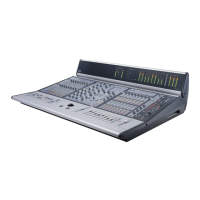Chapter 3: D-Show Control Surface Overview 23
Comp In Switch
This switch toggles the built-in Compressor/Limiter in and
out of circuit. If the switch is lit, the process is in circuit.
Gate In Switch
This switch toggles the built-in Expander/Gate in and out of
circuit. If the switch is lit, the process is in circuit.
EQ In Switch
This switch toggles the built-in EQ in and out of circuit. If the
switch is lit, the process is in circuit.
Input Strip Meters
There are three meters within this section in the channel strip.
D-Show Input (and Output) meters display nominal level.
Input Meter
The 10-segment input meter displays the level of the incom-
ing input signal. A segment lights when the level of the in-
coming signal reaches or exceeds the segment’s correspond-
ing label.
The entire meter lights red if the signal is clipping at any of
the strip’s multiple clip points. Normally, segments up to and
including the segment labeled 0 dB display as green and the
segments above 0 dB display as yellow.
Stereo LED Below the input meter is a Stereo LED. This LED
lights if the associated input strip is stereo. The LED flashes
on/off anytime the strip is stereo and the difference in instan-
taneous peak level between left and right sides is 12 dB or
more.
Comp/Lim Meter
The Compressor/Limiter meter has 6 LEDs to show the
amount of gain reduction being applied to the signal by the
built-in Compressor/Limiter. For more information, see
Chapter 16, “Dynamics.”
Expander/Gate Meter
The Expander/Gate meter has 3 LEDs to show the open/closed
state of the built-in Gate, or the amount of gain reduction ap-
plied by the Expander. For more information, see Chapter 16,
“Dynamics.”
Select Switch
The Select switch on each channel is used to target the chan-
nel in the Assignable Channel Section, and to include the
channel in Multi-Select and Multi-Assign functions. A lit Se-
lect switch indicates the channel is selected. The name of the
currently selected channel is displayed in red in the Channel
Name display and in the ACS Selected Channel display. When
multiple channels are selected, the red Channel Name display
indicates which is channel is currently the ACS target.
Solo Switch
The Solo switch toggles the solo state of that channel. When
enabled, the Solo switch LED is lit. When the channel is in
Solo Safe mode, the Solo switch LED flashes. Channel Solo
latches on a momentary press, and automatically releases if
held for 2 seconds or more and released.
Source Switch
The Source switch changes the Channel Name display to
show the source input which is feeding each channel.
Name Display
This 6–character display shows the name of the channel, or
Source if the Source switch is pressed. The name display for
the currently selected channel is lit red. The channel name
display can show other types of information according to the
state of the Source switch or the current action.
Names This is the default display which shows the abbrevi-
ated channel names on all displays.
Values When a control is moved (or a fader is touched), the
Channel Name display changes to Values display mode,
where it shows each fader level or encoder function level as it
is adjusted. You can turn off Values display switching so that
the Name display does not show fader values. See “LCD Dis-
plays” on page 48.
Source When this switch is pressed, the Name displays show
the source input feeding each channel. Sources are abbrevi-
ated to indicate hardware input source and channel number.
For example, if “S1A1” appears in a Channel Name display
when Source is enabled, it indicates that the channel source is
Stage Rack 1, Card A, Input 1.
Mute Switch
The Mute switch mutes the channel at the (pre-fader) mute
point. Channel pre-fader pickoff is post-mute.
Because the lowest meter level is –30 dB, any input signal
that is less than this value will not register on the input
strip meter. The Selected Channel meter on the meter bridge
and the on-screen meters register activity below –30 dB.

